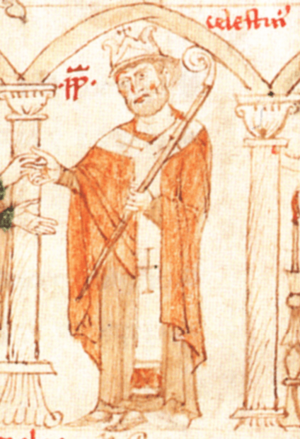Pope Celestine III facts for kids
Quick facts for kids Pope Celestine III |
|
|---|---|
| Bishop of Rome | |

Pope Celestine III, from the Liber ad honorem Augusti (1196)
|
|
| Church | Catholic Church |
| Papacy began | 30 March 1191 |
| Papacy ended | 8 January 1198 |
| Predecessor | Clement III |
| Successor | Innocent III |
| Orders | |
| Ordination | 13 April 1191 |
| Consecration | 14 April 1191 by Ottaviano di Paoli |
| Created Cardinal | February 1144 |
| Personal details | |
| Birth name | Giacinto Bobone |
| Born | c. 1106 Rome, Papal States |
| Died | 8 January 1198 (aged 91–92) Rome, Papal States |
| Previous post | Cardinal-Deacon of Santa Maria in Cosmedin (1144–1191) |
| Motto | Perfice gressus meos in semitis tuis ("Going in Thy path") |
| Signature | |
| Other Popes named Celestine | |
Pope Celestine III (born Giacinto Bobone, around 1106 – January 8, 1198) was the leader of the Catholic Church. He also ruled the Papal States, which were lands controlled by the Pope. He served from March 30, 1191, until his death in 1198. During his time as Pope, he had some difficult relationships with powerful rulers. These included Emperor Henry VI, King Tancred of Sicily, and King Alfonso IX of León.
Contents
Early Life and Church Career
Giacinto Bobone was born in Rome into a well-known noble family called the Orsini family. In 1144, he became a cardinal-deacon. This is a high-ranking church official who helps the Pope. He was appointed by either Pope Celestine II or Pope Lucius II.
Bobone was seen as an expert on Spain by the Roman Curia, which is the Pope's main administration. Because of this, he traveled to Spain twice. These trips, called "legatine missions," happened between 1154–1155 and 1172–1175. He served as the Cardinal-Deacon of Santa Maria in Cosmedin during these missions.
Becoming Pope and His Rule
Celestine was chosen as Pope on March 29 or 30, 1191. He became a priest on April 13, 1191. The very next day after his election, he crowned Henry VI as the Holy Roman Emperor.
In 1192, Celestine recognized Tancred as the rightful king of Sicily. This was a problem because Emperor Henry VI's wife also claimed the throne. Celestine also threatened to excommunicate Henry VI. Excommunication means being formally cut off from the Church. This threat was because Henry VI had wrongly imprisoned King Richard I of England. However, the group of cardinals advising the Pope did not agree, so Celestine could not do much more.
He also placed the city of Pisa under an interdict. An interdict is a punishment that stops church services and sacraments in a certain area. This interdict was later lifted by the next Pope, Innocent III, in 1198.
Dealing with Denmark
In 1192, Pope Celestine sent a cardinal named Cinthius to Denmark. His job was to help solve problems between the Danish princes. After Cinthius returned to Rome, Celestine sent three important letters, called "papal bulls." These letters told Archbishop Absalon of Lund to tell the King of Denmark to free the bishop of Schleswig.
The letters also warned that Duke Valdemar, who had imprisoned the bishop, would be excommunicated. They also threatened to place the entire kingdom of Denmark under an interdict. The bishop remained imprisoned until Pope Innocent III took up the issue again in 1203.
Conflicts with King Alfonso IX
Celestine also spoke out against King Alfonso IX of León. He condemned Alfonso's marriage to Theresa of Portugal. This was because they were too closely related, which was against church rules (called "consanguinity"). As a result, both Portugal and León were placed under an interdict.
Later, in 1196, Celestine excommunicated Alfonso IX. This happened because Alfonso had joined forces with the Almohad Caliphate, a Muslim empire, while fighting against Castile. After Alfonso married Berengaria of Castile, Celestine excommunicated him again and placed an interdict over León.
In December 1196, Celestine issued another important letter. This letter officially recognized the lands and possessions of the Teutonic Knights, a religious military order.
His Final Days
Before he died, Celestine wanted to resign as Pope. He even suggested who should take his place, a cardinal named Giovanni di San Paolo. However, the other cardinals did not allow him to resign. He passed away shortly after.
See also
 In Spanish: Celestino III para niños
In Spanish: Celestino III para niños
- List of popes
- Cardinals created by Celestine III

